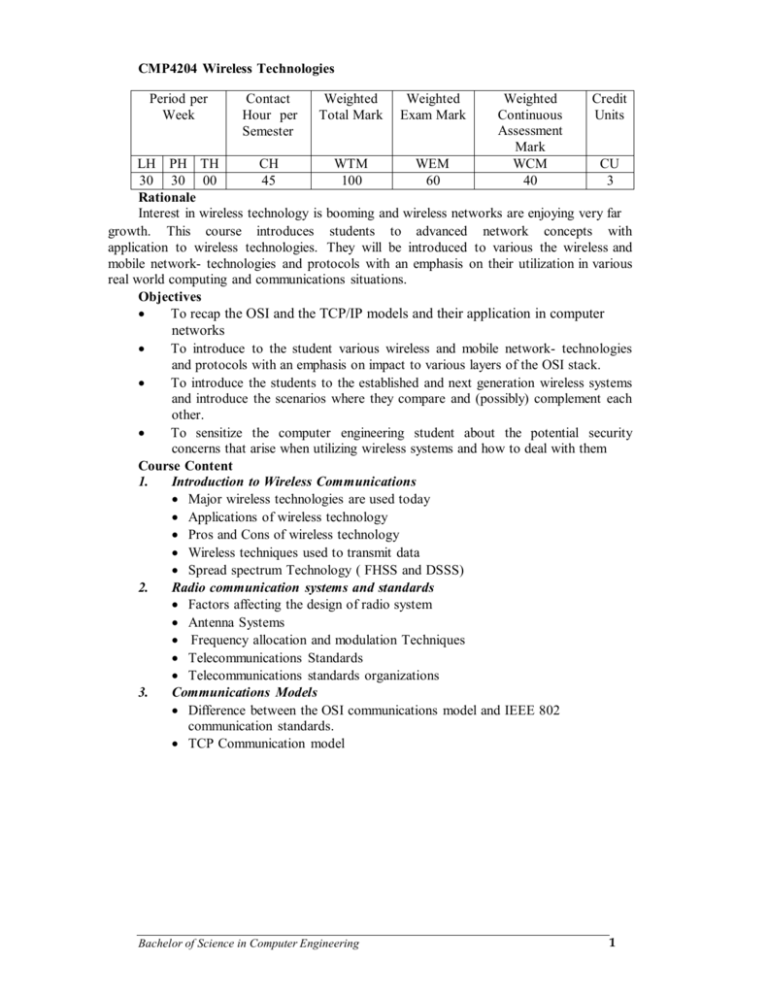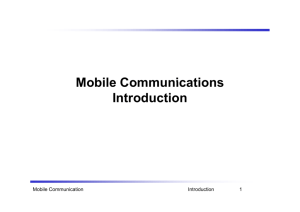
CMP4204 Wireless Technologies
Period per
Week
Contact
Hour per
Semester
Weighted
Total Mark
Weighted
Exam Mark
Weighted
Continuous
Assessment
Mark
WCM
40
Credit
Units
LH PH TH
CH
WTM
WEM
CU
30 30 00
45
100
60
3
Rationale
Interest in wireless technology is booming and wireless networks are enjoying very far
growth. This course introduces students to advanced network concepts with
application to wireless technologies. They will be introduced to various the wireless and
mobile network- technologies and protocols with an emphasis on their utilization in various
real world computing and communications situations.
Objectives
To recap the OSI and the TCP/IP models and their application in computer
networks
To introduce to the student various wireless and mobile network- technologies
and protocols with an emphasis on impact to various layers of the OSI stack.
To introduce the students to the established and next generation wireless systems
and introduce the scenarios where they compare and (possibly) complement each
other.
To sensitize the computer engineering student about the potential security
concerns that arise when utilizing wireless systems and how to deal with them
Course Content
1.
Introduction to Wireless Communications
Major wireless technologies are used today
Applications of wireless technology
Pros and Cons of wireless technology
Wireless techniques used to transmit data
Spread spectrum Technology ( FHSS and DSSS)
2.
Radio communication systems and standards
Factors affecting the design of radio system
Antenna Systems
Frequency allocation and modulation Techniques
Telecommunications Standards
Telecommunications standards organizations
3.
Communications Models
Difference between the OSI communications model and IEEE 802
communication standards.
TCP Communication model
Bachelor of Science in Computer Engineering
1
4.
5.
6.
Low- Speed Wireless Local Area Network
Introduction to WLAN
Components and modes of a WLAN
WLAN and wireless media
The MAC frame format.
Function of an IEEE 802.11b Network
Discuss Mobile IP
Tell how IEEE 802.11a networks function, and how they differ from IEEE
802.11b networks
High Speed WLAN
Mobile IP Technology
IEEE 802.11a networks
Difference between IEEE 802.11a and IEEE 802.11b networks
Advantages and Disadvantages of an IEEE 802.11g networks.
HiperLAN/2 networks.
Low speed and high speed WLANs
Personal Area Network (Bluetooth)
Introduction to Bluetooth
Bluetooth network topology
Piconet
Bluetooth device profiles
7.
Installing and securing an Adhoc network.
Installing, configuring and securing Infrastructure network
Creating Adhoc networks using IEEE 802.11a, b and g client cards.
Security features used in Adhoc networks
Installing and securing an Adhoc network.
Steps for setting up Infrastructure WLAN
Providing security in an enterprise environment.
8.
Wireless MANs.
Cellular, Voice and Data Networks
Cellular networks
Functioning of AMPs CDPD, GSM GPRS and CDMA based systems.
9.
Wireless WAN
Wireless Internet
WAP and its use in wireless internet.
Introduction to WML
Brief introduction to J2ME
Learning Outcomes
On completing this course the student should be able to:
Understand different types of wireless local area network (WLAN) technologies.
Understand the significance that specific layers the TCP/IP protocol have in
wireless communications.
Identify the different types of wireless communications protocols contained in the
IEEE 802.11 WLAN standard.
Identify the most critical antenna design parameters and understand their impact in
Bachelor of Science in Computer Engineering
2
wireless communications.
Understand radio frequency (RF) propagation.
Understand spread spectrum technology.
Demonstrate the ability to design and implement a wireless data collection
system.
Demonstrate the ability to communicate and document technical information in a
professional, structured, timely, and effective manner.
Recommended and Reference Books
[1]
William Stallings, 2005, Wireless Communications and Networks, 2nd Edition,
Pearson Prentice Hall
[2]
Jorge Olenewa, Mark Ciampa, Wireless# Guide to Wireless Communications,
2nd Edition, Thompson Course Technology. ISBN-13 978-1-4188-3699-3
[3]
William Stallings, 2004, Data & Computer Communications, 7th Edition,
Prentice Hall
[4]
William C. Lee, 2005, Wireless and Cellular Telecommunications, 3rd edition,
McGraw Hill
[5]
Fred Halsall, 2005, Computer Networking and the Internet, Addison Wesley
[6]
T.S. Rappaport, 2002, Wireless Communications: Principles & Practice, 2nd
Edition, Prentice Hall
[7]
W.C.Y. Lee, 1998, Mobile Communication Engineering
Bachelor of Science in Computer Engineering
3









